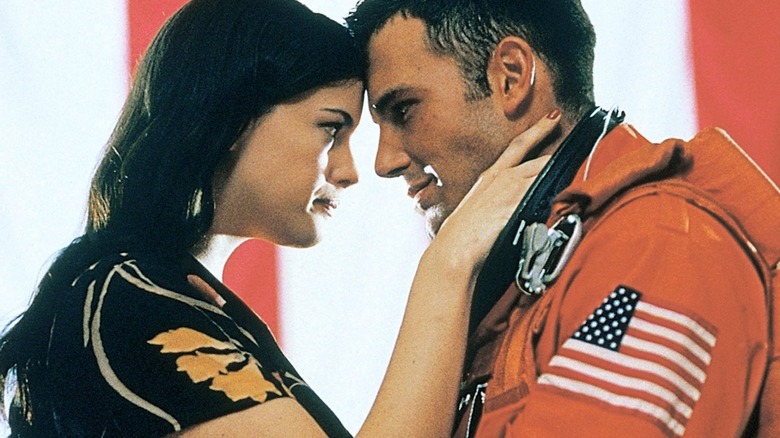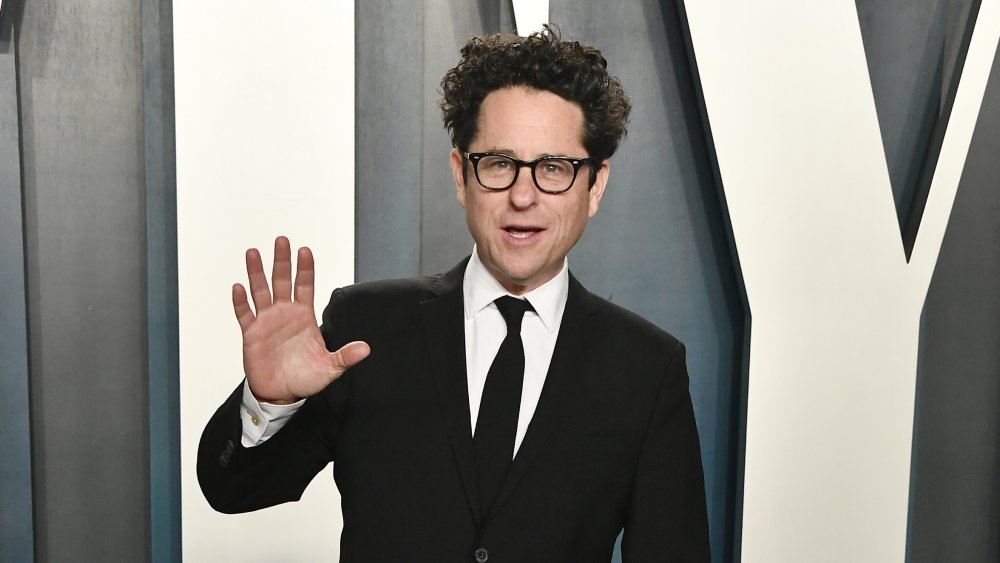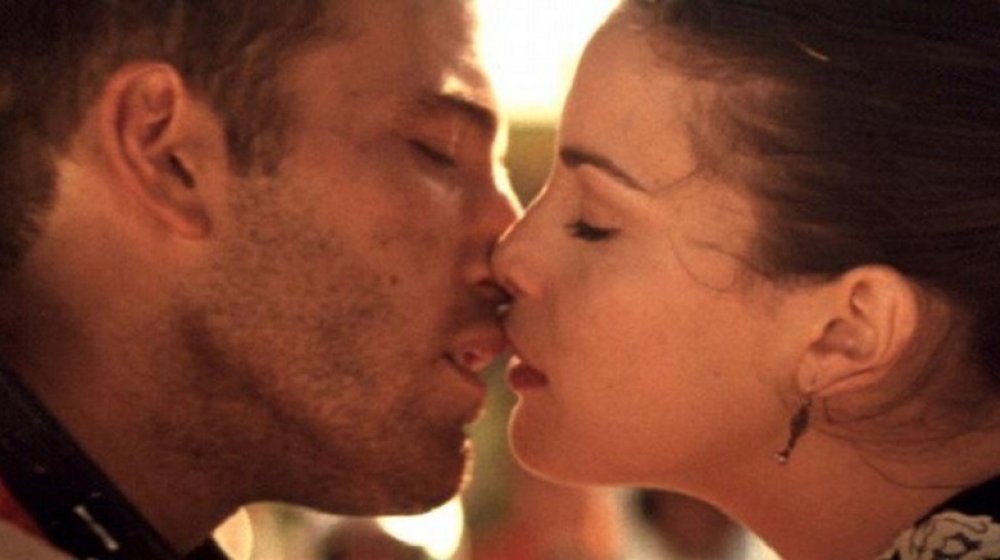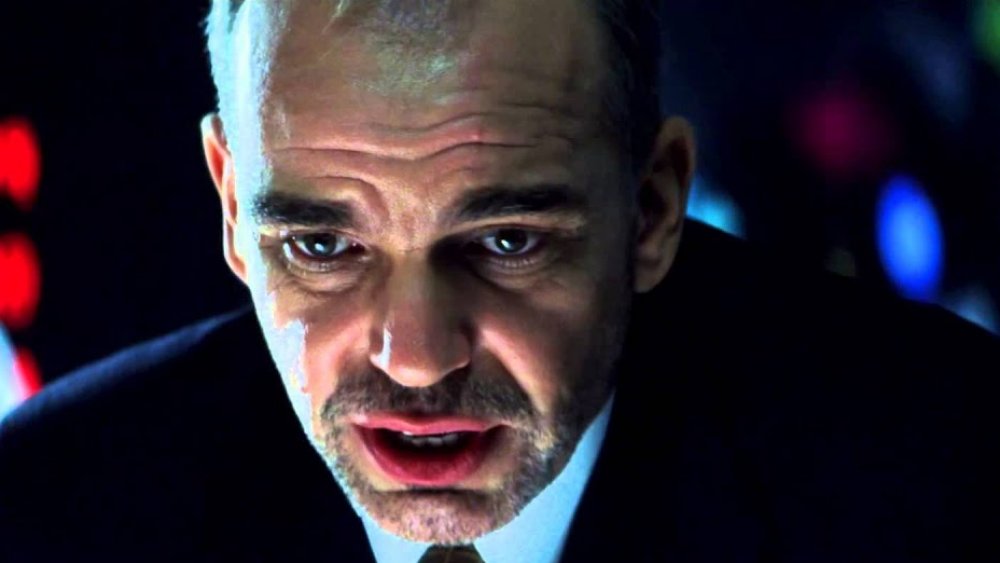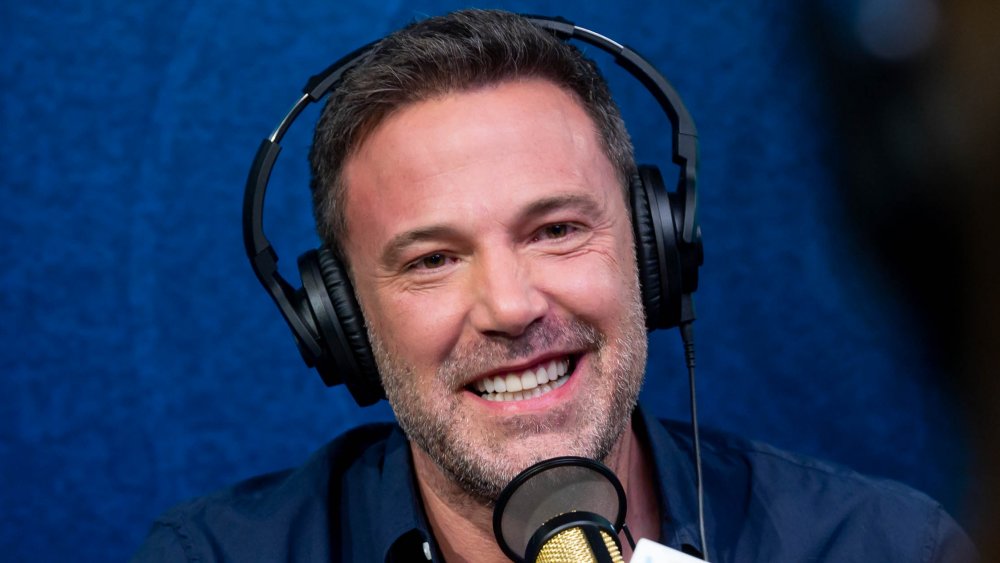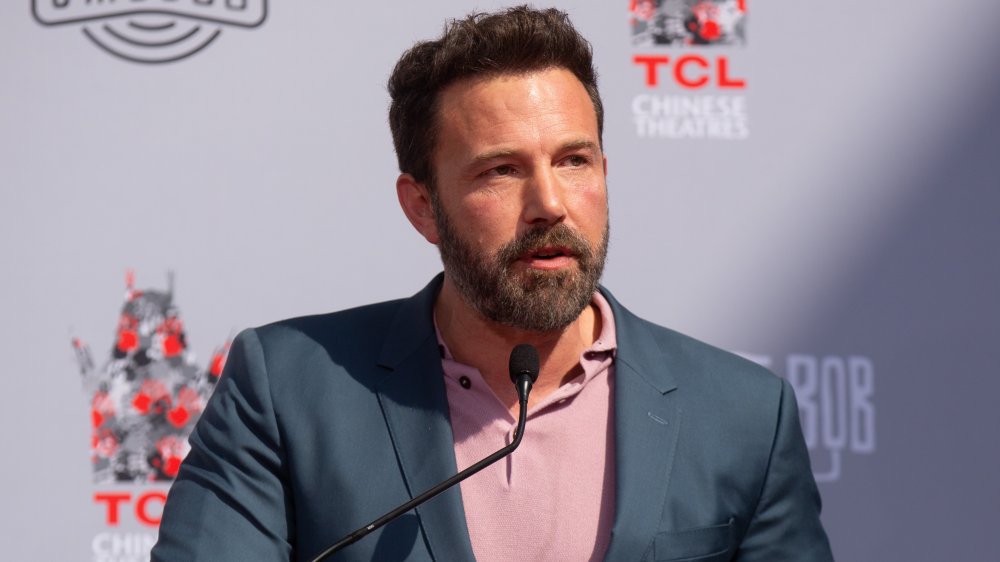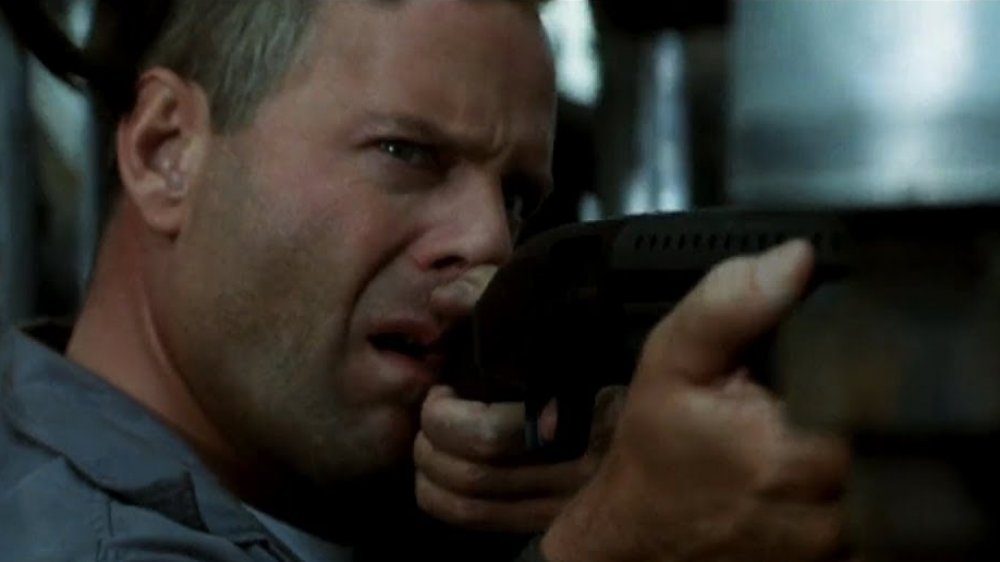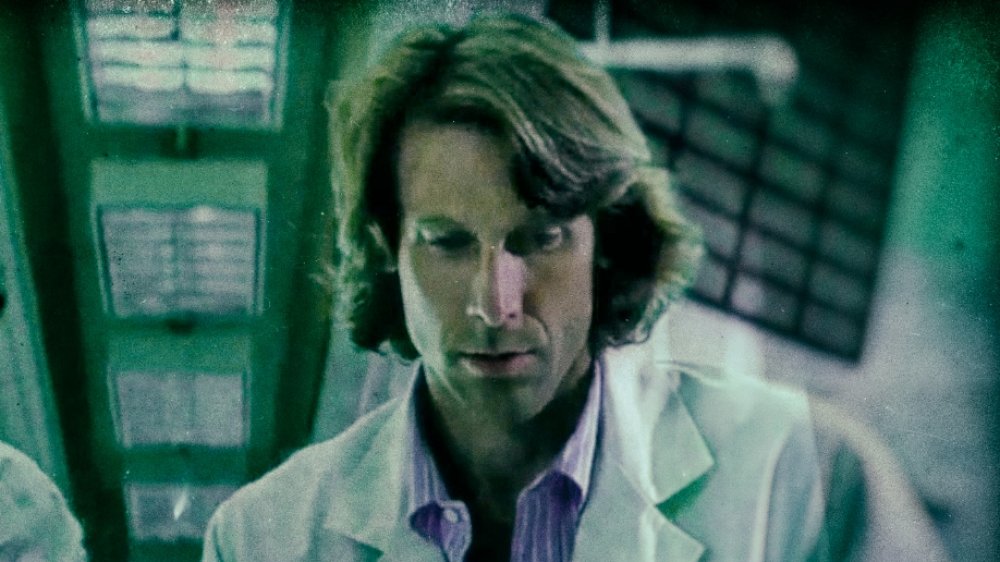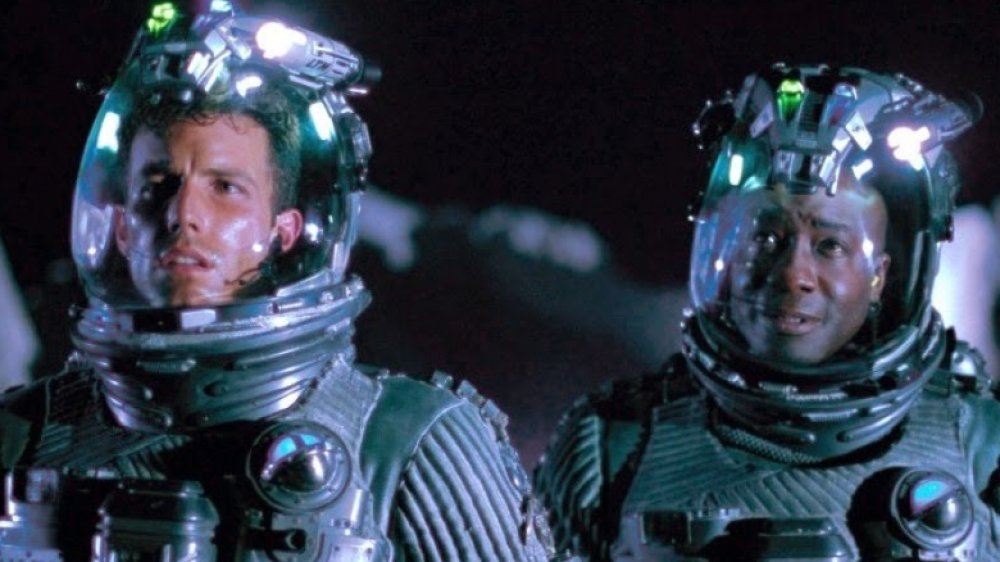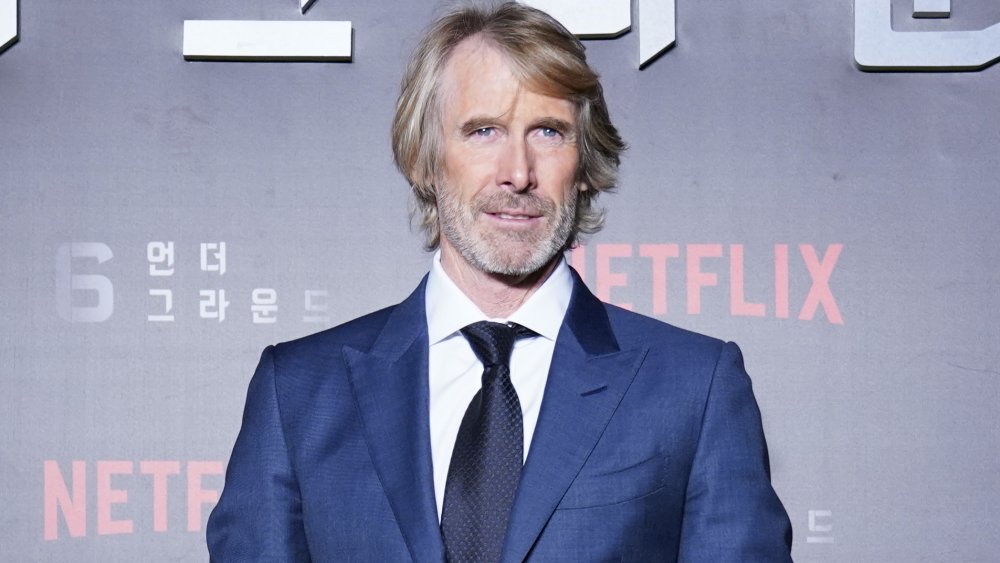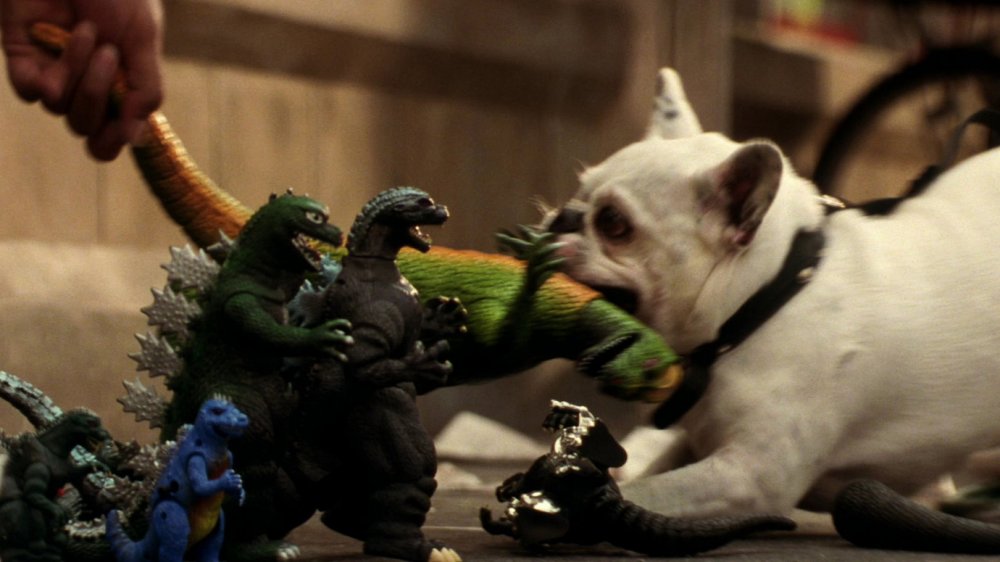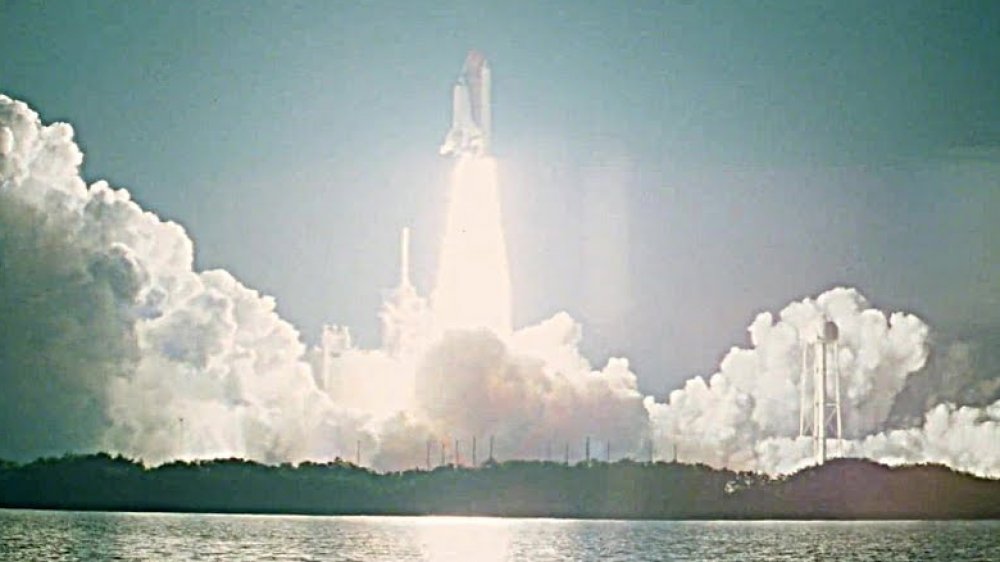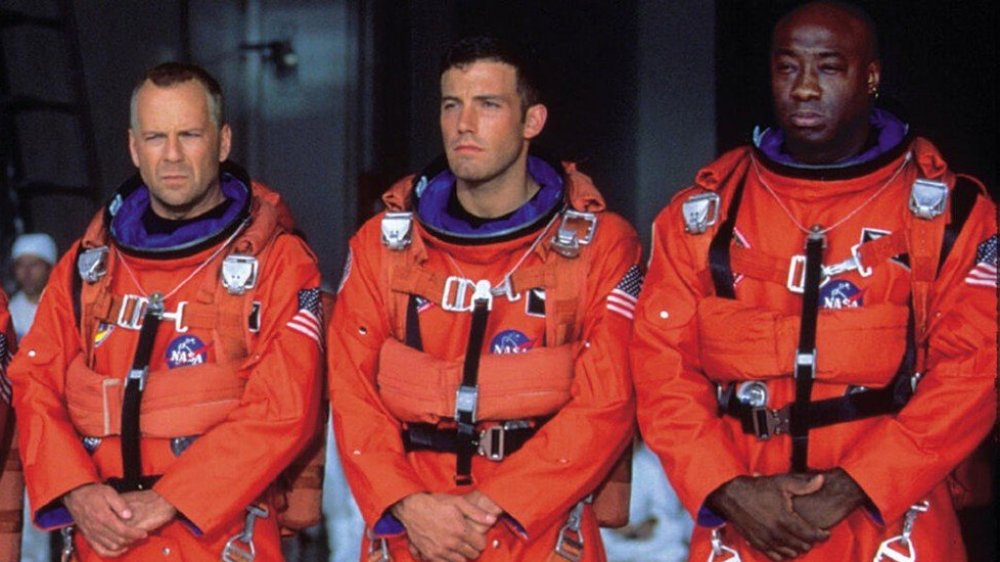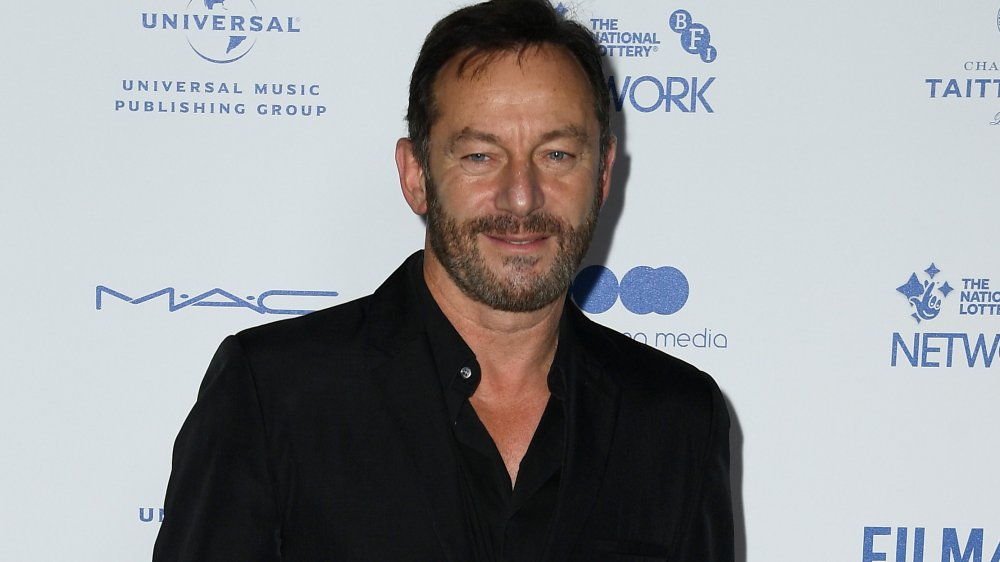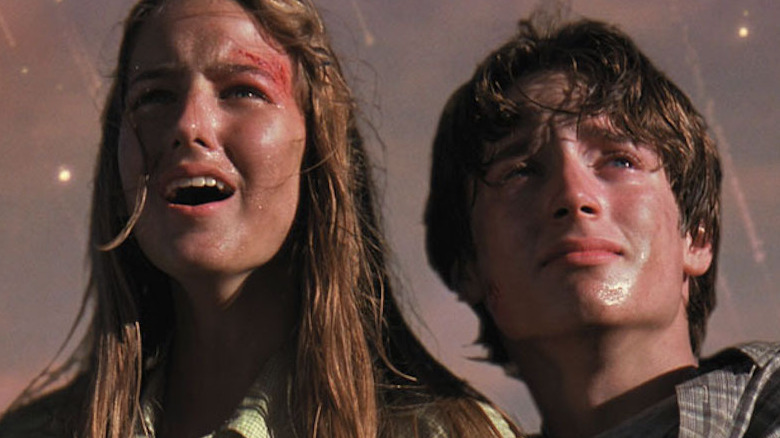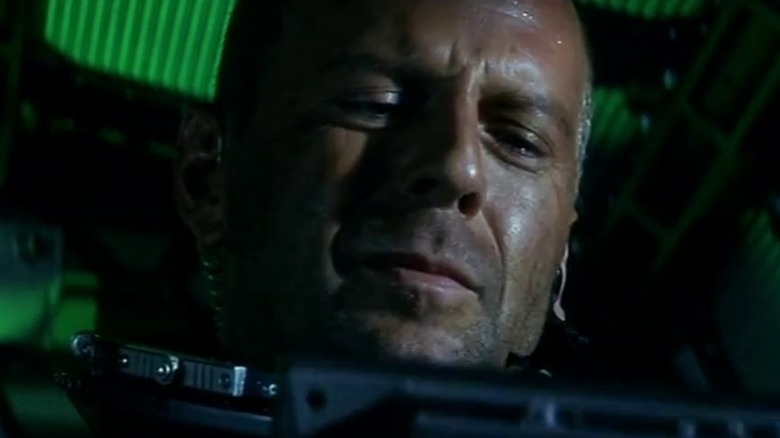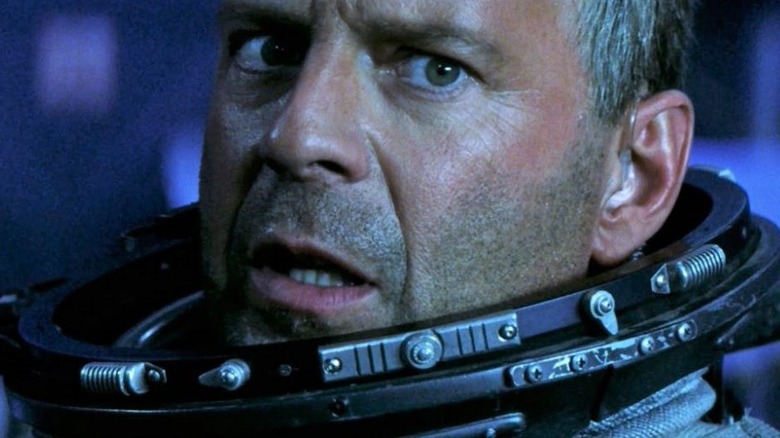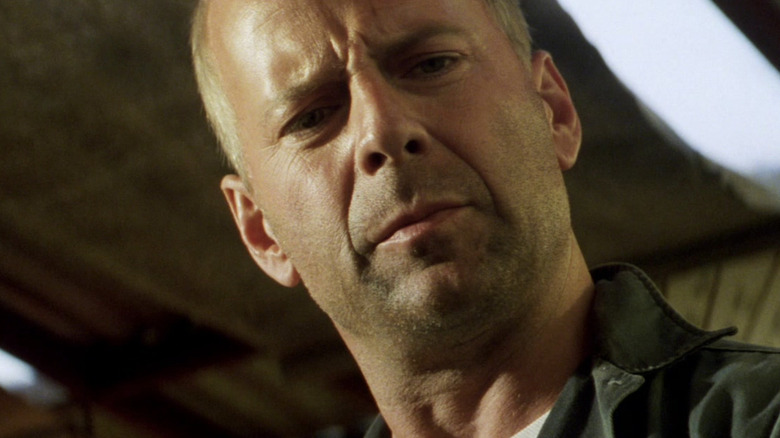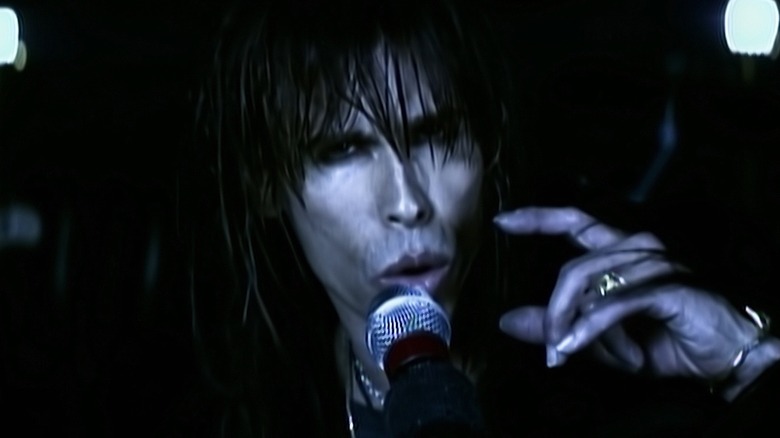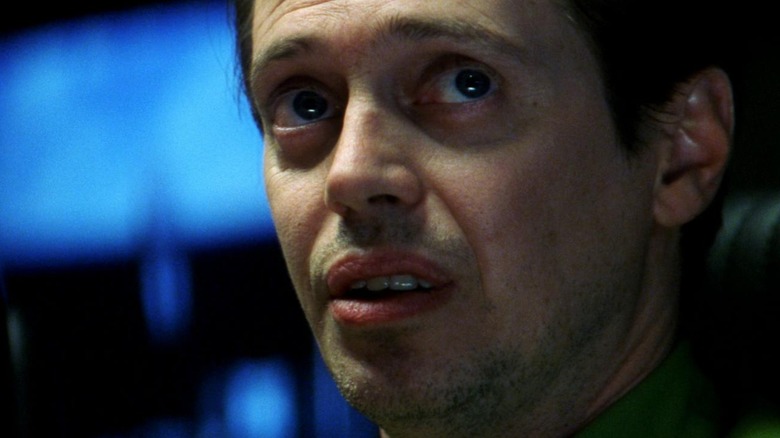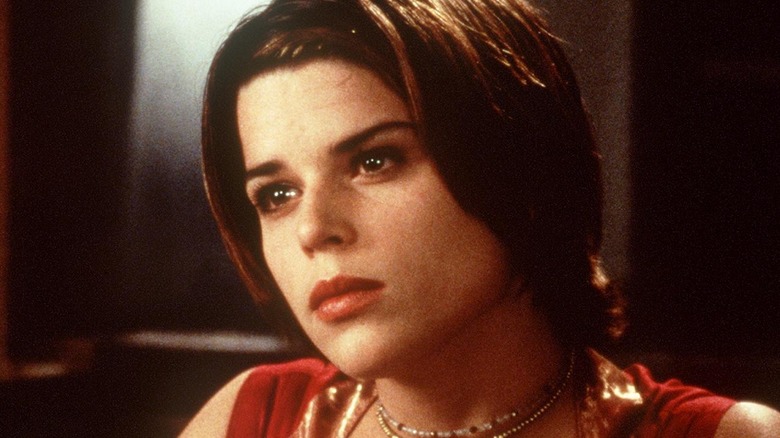Armageddon Facts That You Won't Wanna Close Your Eyes And Miss
We don't know who needs to hear this, but not all movies have to be scientifically accurate, win Oscars, and make us think really hard about the human condition. Sometimes, you just want to watch a bunch of oil drillers — preferably the best oil drillers in the world — learn to be astronauts in a matter of minutes, land a spacecraft on a giant meteor, and try to insert nuclear weapons into it. Throw in some low-angled 360-degree shots, improbable explosions, and unceasing dramatic music, and that just makes it even better.
Even notoriously prickly director Michael Bay admitted in his DVD commentary that the movie isn't exactly rocket science. (Except he said "brain surgery.") In 2001, Bay described the movie to The New York Times as, "a total fantasy for a 15-year-old. ... It's a popcorn movie. It's not supposed to be taken seriously."
However, the shooting of "Armageddon" was a very serious business, involving multiple rewrites, real shuttle launches, a spacesuit disaster, and extreme dental surgery. Here's what happened behind the scenes to make the finest movie ever made about a meteor on a collision course with Earth (at least since "Deep Impact" premiered the month before).
J.J. Abrams helped rewrite Armageddon's script
One person you can thank or blame for "Armageddon" is J.J. Abrams. Today, the director/producer/geek-in-chief is the mastermind behind massive sci-fi projects including the "Star Wars" and "Star Trek" franchises, not to mention "Lost." But back in the late '90s, Abrams was a script doctor being paid to rework screenplays that weren't quite clicking, often without credit. Thanks to his mentor Steven Spielberg, we know he also worked on 1995's "Casper," but Abrams' other contributions to pop culture remain as elusive as the friendly ghost. And he's probably fine with that, since he wasn't keen on all of them. Speaking about his script doctor days, he diplomatically told The Guardian, "Over the years [I] had found myself doing things that weren't so meaningful."
Abrams can't take all the credit (or wrath) for "Armageddon." Eight other writers were involved in the project at one point or another. Robert Roy Pool wrote the original script, which was reworked by Jonathan Hensleigh into the version that was greenlit, and the other writers added polish until the movie got lift off. But in June 1998, a Writers Guild of America arbitration committee decided that only five — including Abrams — could attach their names to the movie and get that blockbuster boost on their resumes.
Ben Affleck felt awkward kissing Liv Tyler
Ben Affleck has appeared in more than one awkward love scene — and the entirety of "Gigli" — but he was still uncomfortable filming his character's romantic moments with Liv Tyler. According to Cinema.com, Affleck claimed that kissing Tyler was like making out with his sister.
Tyler confirmed that the romantic element was hard. On the one hand, she told Cinema.com, "He's my friend. It was nice because we know each other's families and boyfriends and girlfriends, which made it all cool." But that familiarity made the love scenes hard to film. "We would just start giggling like crazy," Tyler recalled. Evidently, some audience members picked up on that cringey chemistry, as the actors earned the dubious honor of a Golden Raspberry (aka Razzie) nomination for Worst Screen Couple in 1999. (Affleck finally scooped that prize with Jennifer Lopez for "Gigli" and again for his frenemy-ship with Henry Cavill's Superman in "Batman v Superman: Dawn of Justice.")
Billy Bob Thornton has no regrets about doing Armageddon
If you were watching "Armageddon" and wondering why Billy Bob Thornton was in the movie, well, you're in good company. According to Thornton, at the table read, Steve Buscemi wondered aloud why he and Thornton had been cast. But Thornton knew. As the actor explained to People TV, his manager had suggested to producer Jerry Bruckheimer — on a plane ride the two just happened to share — that he should cast "some really good, like, actors' actors."
"Armageddon" may not be on par with some of Thornton's other work, but the actor isn't snobby about appearing in the popcorn crowd-pleaser. He told IndieWire, "I don't really do blockbusters, but I thought on the level that it was supposed to work, I always thought it did, and I enjoyed my time on that movie." And while "Armageddon" doesn't have the emotional clout of, say, "Monster's Ball" or "Friday Night Lights," the emotional climax still gets Thornton. "Every time, when Bruce Willis is buying the farm on the rock ... I tear up." And no, it's apparently not out of embarrassment.
Michael Bay made Ben Affleck get a new set of teeth
Fans of Ben Affleck's earlier films may have noticed something different about him in "Armageddon." In his director's commentary, Bay revealed that he made the actor get a new set of teeth. According to Bay, Affleck was stuck in a dentist's chair for eight hours a day for a whole week, at a cost of $20,000 to the movie's jaw-droppingly high budget. Yet when Steve Buscemi expressed a desire to straighten out his own teeth after watching the movie, Bay told him not to.
That dental work stayed with Affleck through many more leading roles, literally and metaphorically. His co-star in 2001's "Pearl Harbor," Kate Beckinsale, recalled that when Bay forced her to lose weight for the movie, Affleck commiserated with her by telling her about his tooth woes. "I was like, 'Cool, at least I get to hang on to my actual teeth,'" she told Women's Health (via ET).
Ben Affleck takes issue with a major Armageddon plot point
Everyone knows the plot holes in "Armageddon" are the size of a meteor the size of Texas. Even Ben Affleck knows it. In 1999, the "Armageddon" DVD was released with commentary from Affleck, Michael Bay, and Bruce Willis. It became perhaps the most famous DVD commentary ever — admittedly not a tough category — thanks to Affleck's running mockery of his own movie.
At one point, Affleck explained that he'd asked Bay about what he felt was one of the movie's most glaring issues. "I asked Michael why it was easier to train oil drillers to become astronauts than it was to train astronauts to become oil drillers, and he told me to shut the f*** up," Affleck said, before launching into a take down of the movie's central premise.
Over 20 years later, Affleck still isn't over this gaping plot hole, but he's not letting it tarnish his memories of working on the movie. "I knew enough to know this isn't really an Oscar type movie, this is a fun movie ... I have some great memories from that movie," he told GQ.
Astrophysicists like to take aim at Armageddon
If you've spent most of your life studying meteors, watching Hollywood get everything wrong about them is deeply frustrating. So it's not surprising that astrophysicists enjoy destroying "Armageddon."
One of their main issues is the size of the meteor. In bad news for movie purists but good news for humanity, the chances of a meteor that size hitting Earth is "very small," according to Edinburgh University PhD student Alastair Bruce. He points out that the most catastrophic meteor to ever hit Earth was 10 km (6 miles) wide. That's the one that wiped out the dinosaurs (and triggered another scientifically inaccurate '90s blockbuster). The meteor in "Armageddon" is approximately 10,000 km (6,000 miles) wide.
In more good news for real-life Earth dwellers, Bruce said we'd definitely be able to see something that big "at least a few months before it hit," rather than 18 days in advance. But it's bad news for any presidents who were planning to rely on the movie's plot for guidance should such an event occur. "The whole idea that you can blow it up with a single nuke is just stupid," Bruce summarizes.
Did you spot Michael Bay at NASA?
Many years before Michael Bay was spending millions of dollars to blow things up on movie sets, he starred in an amateur production of "Pirates of Penzance." As told to GQ, his own mother's review was, "I never laughed so hard in my life." So it's probably for the best that Bay mostly moved away from acting.
We say "mostly" because despite his early struggles, he's appeared on-screen numerous times. He played a NASA scientist in a couple of scenes in "Armageddon" — the one who's told, "We're moving to Hubble." He also gave himself cameos in "Bad Boys II" (as the driver of the car that Will Smith rejects) and in "6 Underground" (as a reporter). He even made time to play an MC in "Bad Boys for Life," at the invitation of his replacements at the helm, Adil El Arbi and Bilall Fallah.
Bay has also popped up in other people's projects. His acting credits include Goon #3 in a 1986 episode of "Miami Vice," Frat Boy in the superhero comedy "Mystery Men," and a photographer in the rom-com "Coyote Ugly." And who knows who's underneath all that "Transformers" CGI?
A real oil rig let Armageddon shoot on location because of the plot
Oil rigs aren't known for being hospitable to people who aren't trained oil drillers. But Bay managed to sweet talk his way into shooting on a real oil rig, making "Armageddon" one of the few movies granted that honor. In his director's commentary on the 1999 DVD, Bay said he thought that the plot of the movie — oil riggers save the world — was the deciding factor, proving once again that representation matters.
Specifically, "Armageddon" was shot on the Garden Banks Oil Rig, 180 miles from the Gulf Coast of Texas. Chief lighting technician Andy Ryan told LiveDesignOnline that all the equipment had to be driven from LA to Galveston, TX, then shipped to the rig on barges. The lighting crew had to go out four days early to set everything up. But after that, it was a remarkably smooth process. "We took a two-hour helicopter ride to get out there, and within two hours we were shooting. Piece of cake," Ryan said.
Michael Bay is not sorry for making Armageddon
Movie lovers who didn't appreciate Bay's vision for "Armageddon" may have felt a little smug when it was reported that he'd apologized for making the movie in an interview with the Miami Herald in 2013. Bay's quote in the article, as reported by The Guardian, was, "I will apologize for 'Armageddon' because we had to do the whole movie in 16 weeks. It was a massive undertaking." Some thought he was criticizing the movie's fast and loose interpretation of science. But in a now-vanished post published on his blog, Bay clarified that he was only — sort of — apologizing for part of the movie.
He wrote that what he actually regretted was that he hadn't had enough time to properly edit the movie's final act. "I said, I wish we had a few more weeks in the edit room on 'Armageddon,'" Bay wrote, as quoted in The Guardian. But he still stands by all two-and-a-half hours of the final product. "And still today 'Armageddon' is one of the most shown movies on cable TV. And yes, I'm proud of the movie. Enough said," he clarified with an almost audible mic drop.
The Godzilla-fighting dog had a big pay day
The real scene-stealer from "Armageddon" was Little Richard (Franky), the French bulldog that falls into a meteorite crater (he's rescued by his dedicated owner, played by Eddie Griffin). In real life, Franky belonged to Brendan Kelly, an actor who'd appeared in "Armageddon" producer Jerry Bruckheimer's previous movies "Con Air" and "The Rock" — connections that landed Franky the "Armageddon" job.
In his DVD commentary, Bay said that Franky cost $20,000 a day and was so good at attacking the Godzilla toys in the opening sequence that the crew had to hide them. However, Variety reported that Franky and Kelly made $20,000 for the whole project — which isn't bad for a couple of scenes.
Kelly made the most of Franky's opportunity. While on set, he put together a short film titled "Franky Goes to Hollywood," which showed Franky getting acting advice from Billy Bob Thornton, a career pep talk from Bruce Willis, and kisses from Liv Tyler, among other exciting adventures. Franky quit showbiz while he was ahead, but Kelly went on to have small roles in "The Lizzie McGuire Movie," "CSI: NY," and "Angel Has Fallen," among others.
NASA allowed the filmmakers to shoot a real launch
The most realistic thing about "Armageddon" is the launch sequence, as the team filmed two real shuttle launches at the Kennedy Space Center near Orlando, FL. The first, done in daytime, was a practice to get camera angles and lighting correct. But filming the night launch was tense. John Schwarztman, director of photography, explained on Bay's blog that these are only done every 18 months. "We knew if we didn't get it right, there was no second chance," he said. NASA also allowed Bay to film in their six million-gallon neutral buoyancy tank at the Johnson Space Center in Houston, TX. It's effectively a giant swimming pool where trainee astronauts practice doing extravehicular activities (EVA) — aka space walks.
Even Bay was overwhelmed by the scale of the shuttle. He told NASA that filming those sequences was "one of the truest things about being an American." But he was less impressed with the NASA offices. In the DVD commentary, he revealed that those scenes were shot in offices used by a company selling herbal products. "If you saw the real NASA, you wouldn't trust it as far as you could throw it," he added.
Michael Bay threw out the original spacesuits
Bay knew that making an awesome space movie came down to one thing — the spacesuits. In the DVD commentary, he said that these costumes were "the biggest nightmare of the entire shoot." According to Bay, when he went to check on the costumes three weeks before shooting began, the suits looked like "an Adidas jogging suit on a rack." His breaking point came when he found someone spray painting a glove from a gardening store gray and sewing rubber to the knuckles. He estimated that it ultimately cost about $1.5 million to get them right.
The final costumes made a deep impact (ahem) on NASA. They asked Chris Gillman, who designed the helmets, to design real spacesuits. Gillman is well-known for making space come to life in movies, having designed and made props and costumes for projects including "Stargate," "The Astronaut Farmer," "First Man," and "Ad Astra." He helped redesign a NASA suit to fit smaller torsos, and he designed a helmet adapter. Gillman's NASA connection runs in his family — he welding company his dad owned worked on the life support systems used in the Apollo missions.
Jason Isaacs nearly had a much bigger role in Armageddon
In "Armageddon," British actor Jason Isaacs plays Dr. Ronald Quincy of NASA research, the man tasked with explaining why burying nuclear missiles inside the meteor is the only way to save Earth from the "global killer." But he nearly got to do so much more.
In 2019, Isaacs explained to The A.V. Club that he was shooting an unnamed independent movie in Ireland (possibly "Divorcing Jack") when he got a call saying he'd been cast as one of the "Armageddon" astronauts, and that he had to report to set immediately. When Isaacs refused to abandon the project he'd already committed to, the surprised executives offered him a smaller part.
Isaacs explained, "They came back and offered me the ... consultation prize of playing the part I played in 'Armageddon' ... The whole time, I was looking at the astronauts thinking, 'Oh, I could've been you. It could've been me in that orange jumpsuit.'" Apparently being "pretty much the smartest man on the planet" doesn't matter nearly as much on film sets as top billing. "There's tiers of hierarchy on film sets ... and any time someone was a bit iffy with me, I wanted to go, 'I could've had your f****** job,'" Isaacs lamented.
Armageddon vs. Deep Impact
"Armageddon" wasn't 1998's only movie about a celestial object on a cataclysmic collision course with the Earth. Two months before Touchstone's asteroid movie "Armageddon" opened in July 1998, Paramount's comet-oriented "Deep Impact" arrived. Both movies were big financial hits that didn't seem to pull business away from each other — "Armageddon" earned $201 million in the U.S., "Deep Impact" took in $140 million — but some corporate misbehavior, if not downright theft, may have been at play in the battle of the death-from-above movies of 1998.
According to Starlog, "Deep Impact" had been kicking around Hollywood for about 20 years. Producers David Brown and Richard Zanuck approached Steven Spielberg with the idea in the '70s, and the filmmaker eventually merged it with other projects — he'd bought the rights to Arthur C. Clarke's runaway asteroid novel "The Hammer of God" and there was a new, unconnected script by Bruce Joel Rubin. Around 1997, "Deep Impact" was in production under that name, with the studio trying to rush filming because Disney had begun work on a similar-sounding movie, which would become "Armageddon." Rubin alleged in "Tales from the Script" that while meeting with Disney about another project, he'd discussed "Deep Impact" in detail, and the executives took frantic, copious notes.
The "Armageddon" camp reportedly kept abreast of the competition during filming, too. Filmmaker Michael Bay allegedly snuck into Paramount headquarters during "Deep Impact" production and stole raw, unedited footage for reference and comparison purposes.
Armageddon filmmakers shot the climax first
Movies are rarely filmed in narrative order. Production crews set up scenes to be filmed out of sequence, based on technical and financial concerns, and it requires some significant mental prep work for actors to determine just where on their character's emotional journey they are when filming on any given day. "Armageddon" was no exception, and according to the movie's DVD commentary track, one of the first scenes filmed on day one of shooting was the highly memorable and emotionally devastating climax — when oil crew leader/astronaut Harry Stamper (Bruce Willis) bids farewell to his daughter, Grace (Liv Tyler) via video link-up from space, where he's sacrificing himself to make the asteroid diversion mission a success.
In order to get into the proper emotional and psychological headspace required for such a sequence, Willis filmed the tearful goodbye while looking at pictures of his real-life children. Imagining himself saying goodbye to his daughters as he faced eminent death got the tears rolling for the actor.
Bruce Willis didn't really want to do Armageddon
"Armageddon" is just one of multiple crowd-pleasing action-heavy mega-hits on Bruce Willis' resume. But it's not a movie he particularly wanted to film — in fact, he might never have shot it were it not for the unique business-based circumstances surrounding his casting. Essentially, he was more or less forced into starring in the film. In early 1997, Willis started shooting the romantic sports comedy "Broadway Brawler," playing a down-on-his-luck former hockey great who finds romance and purpose at midlife. Willis also produced the film, but after 20 days of shooting, he stopped everything, firing director Lee Grant, cinematographer William Fraker, and costume designer Carol Oditz. An attempt to restart with director Dennis Dugan, a colleague from Willis' "Moonlighting" years, went bust after a day, and "Broadway Brawler" ended production.
Production company Cinergi had already spent $17 million on the film. To satisfy costs and debts, Cinergi executives asked parent company Disney to foot the bill. Disney head Joe Roth agreed to take care of it, on one provision: Willis would have to star in multiple Disney-produced movies for a salary of $10 million each, about half of his usual rate. The first mandated movie Willis made, for Disney-owned Touchstone Pictures: "Armageddon."
Bruce Willis didn't like working on Armageddon
With legal matters all sorted out, Bruce Willis signed on to "Armageddon." But when the process of actually making the film began, it wasn't something the actor seemed to particularly enjoy. While talking up a fourth "Die Hard" movie in 2007, Willis posted on the forums of movie discussion site Ain't it Cool News (via Rotten Tomatoes), first anonymously and then after revealing his identity. Therein he skewered "Armageddon" director Michael Bay. "[He] would have ruined DH4," Willis wrote of a theoretical scenario in which his former collaborator helmed the latest "Die Hard" entry. "Few people will work with him now, and I know I will never work with him again." Willis later clarified that while he appreciated the crew and his fellow actors, it was Bay who made for a miserable experience. "A screaming Director does not make for a pleasant set experience."
Bay was taken aback by Willis' comments. "I loved working with Bruce. He gave me a big hug one month ago," Bay wrote on his blog. "We talked for 20 minutes. We even talked about working together again!"
How Aerosmith got ready for Armageddon
The "Armageddon" soundtrack spawned a hit song in the movie's romantic power ballad "I Don't Want to Miss a Thing," as performed by Aerosmith. The tune hit #1 on the Billboard Hot 100 in 1998, mere months after a similar love song from a disaster movie reached the top of the pop chart. The "Titanic" cut "My Heart Will Go On" went to #1 as sung by Celine Dion — an intended candidate, initially, to perform "I Don't Want to Kiss a Thing," songwriter Diane Warren told ShortList.
Warren's inspiration for the song was another pop diva. "Someone told me there was an interview with Barbra Streisand and her husband and he had said how he doesn't like to go to sleep, you know, if he misses her." Warren said. She thought that would make a good song, and the lyric "I don't want to fall asleep, 'cause I'd miss you, babe" became central to "I Don't Want to Miss a Thing."
Filmmakers lobbied Aerosmith to perform the song by playing to lead singer Steven Tyler's emotions. The band viewed an early rough cut of the film, and the climactic scene, in which the daughter of Bruce Willis' character watches her father die, cut to his core. That's in no small part because Tyler's daughter Liv portrayed that character. "She starts crying and she yells, 'Daddy!' The tears started running down and I said, 'I'll do the song, I'll do the song,'" the musician told MTV News.
Armageddon is a comedy
"Armageddon" combines action, science fiction, and romance, but it isn't outwardly a comedy. That didn't stop producer and director Michael Bay from approaching the movie as if it were. "I've heard him describe 'Armageddon' — at least structurally — as a comedy," Matt Cohan, Vice President of Bay's production company Bay Films, told GQ, "in the tradition of the old Laurel and Hardy or Abbott and Costello fish-out-of-water comedies."
Bay added that he felt it made sense to play up the laughs in a movie about oil-drilling outsiders invading the staid world of scientists. "It's supposed to be a joke. It's about making fun of the system," he said.
To that end, there's plenty of improv in the final cut of "Armageddon." The scenes of the oil workers undergoing testing at NASA were largely unscripted, according to the film's DVD commentary track. And for the scene in which each of the workers writes down their specific demands for taking the asteroid gig, Bay asked each of the actors to come up with their character's wish. Bruce Willis improvised his reactions, based on what his costars wrote down.
Big stars said no to Armageddon
When filming on "Armageddon" began, director Michael Bay wound up with a star-packed cast of esteemed actors, major movie icons, and rising talents, led by Bruce Willis, Ben Affleck, Liv Tyler, Billy Bob Thornton, Steve Buscemi, and Owen Wilson. It's hard to imagine now, but "Armageddon" would have been a completely different film had the actors initially pursued to play the main characters not passed on the opportunity.
Michael Bay revealed on the film's DVD commentary that in his initial approach to "Armageddon," he thought that Sean Connery, with whom he'd just worked on "The Rock," would be the ideal fit to play oil crew boss Harry Stamper. He decided to go for Bruce Willis when he learned that real-life roughnecks probably wouldn't be as old as Connery. Skeet Ulrich, at the time riding a wave of popularity for his breakout role in "Scream," decided to play Vincent in the Oscar-collecting "As Good as It Gets" instead of accepting the role of A.J. Frost in "Armageddon." "I had turned down a couple of films just to do that one. I turned down 'Armageddon,' Ben Affleck's part," Ulrich said at the 2019 Capital City Comic Con.
In 2018, Ulrich's "Scream" co-star Neve Campbell mentioned on "Watch What Happens Live" that she passed on the role of Grace Stamper in "Armageddon." Grace would eventually be played by Liv Tyler, who also turned down the part multiple times before accepting.
